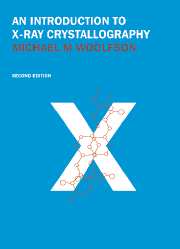Book contents
- Frontmatter
- Contents
- Preface to the First Edition
- Preface to the Second Edition
- 1 The geometry of the crystalline state
- 2 The scattering of X-rays
- 3 Diffraction from a crystal
- 4 The Fourier transform
- 5 Experimental collection of diffraction data
- 6 The factors affecting X-ray intensities
- 7 The determination of space groups
- 8 The determination of crystal structures
- 9 Accuracy and refinement processes
- Physical constants and tables
- Appendices
- Solutions to Problems
- References
- Bibliography
- Index
9 - Accuracy and refinement processes
Published online by Cambridge University Press: 11 January 2010
- Frontmatter
- Contents
- Preface to the First Edition
- Preface to the Second Edition
- 1 The geometry of the crystalline state
- 2 The scattering of X-rays
- 3 Diffraction from a crystal
- 4 The Fourier transform
- 5 Experimental collection of diffraction data
- 6 The factors affecting X-ray intensities
- 7 The determination of space groups
- 8 The determination of crystal structures
- 9 Accuracy and refinement processes
- Physical constants and tables
- Appendices
- Solutions to Problems
- References
- Bibliography
- Index
Summary
The determination of unit-cell parameters
When a crystal structure is solved and refined the solution appears as a set of fractional coordinates from which can be determined bond lengths and angles, van der Waals distances, etc. However the accuracy with which these quantities can be determined will depend not only on the accuracy of the atomic coordinates but also on the accuracy of determination of the unit-cell parameters.
By the measurement of layer-line spacings or from Weissenberg photographs one can usually measure cell edges to about 1% and angles with an error of about ½°. The order of accuracy of cell dimension required to match that of coordinate determination is about one part in a thousand or perhaps a little better. This would correspond to less than 0.002 Å in a bond of length 1.500 Å and rarely is this order of accuracy really required.
For some other purposes more accurate unit-cell parameters may be required – for example for measurement of thermal expansion coefficients of crystalline materials or for investigating small changes in cell parameters with changes of composition of the material.
There has been a great deal of work in this field and it would be difficult to mention it all. What will be done is to select an example of each of the main types of method to illustrate the ranges of techniques and accuracy which are available.
The basic idea behind all the methods is to measure the Bragg angle for a number of reflections. This is related to the reciprocal-lattice constants as follows.
Information
- Type
- Chapter
- Information
- An Introduction to X-ray Crystallography , pp. 301 - 324Publisher: Cambridge University PressPrint publication year: 1997
